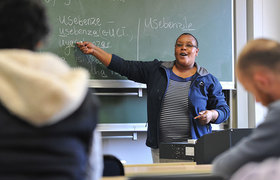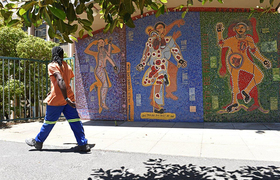Teaching in the digital age
27 July 2015
In our digital age, technology can be an effective teaching tool – provided the teacher has been equipped to use it.
The Teaching with Technology initiative – run by the Centre for Innovation in Learning and Teaching (CILT) – works with UCT educators to develop their capacity to use technology more effectively in the classroom.
The initiative goes beyond workshops and seminars to include design and teaching partnerships with academics who want to put what they have learnt at the workshops and seminars into practice.
"CILT also offers start-up grants from the Mellon Foundation to educators, to support the use of educational technology in their teaching. These grants can be used to address particular teaching and learning challenges faced by themselves or their students," says CILT director Assoc Prof Laura Czerniewicz.
Michelle Henry, convenor of a course on numbers in the humanities, found the use of Google Drive invaluable when teaching her course. "We used Google Drive for online collaboration with students on an assignment in the course. (CILT's) Ian Schroeder and I ran workshops for students to teach them how to use Google Drive. We also trained the lecturers to use Google Drive and Doctopus [a Google Spreadsheet script that helps teachers manage the fl ow of shared work in their Google Drive account]." The most satisfying aspect of this collaboration with CILT was her greater acquaintance with the more technical side of technology, and the knowledge she gained of her students' digital literacy capabilities.
Andrew Petersen, an education specialist in the Schools Development Unit, praised the CILT facilitators for their responsiveness "to the needs of staff as well as student groups. CILT provides good support for personal development, and serves as the perfect platform for innovative eLearning".
He also found that regular workshop attendance has greatly improved his digital literacy: "I now confidently use various applications such as Scoop it! (a curation tool), Hootsuite and Twitter, aggregation tools, Mendeley, and the Google suite of apps, which are management tools."
Dr Aditi Hunma from the Humanities Education Development Unit believes her interaction with the programme has made her more flexible and responsive in curriculum design. "I think that the programme encourages innovation and creative design in developing, in my case, reading and writing pedagogies that are more fluid and responsive to students' needs (as opposed to a fixed and static course reader). There is also much support from CILT staff in terms of thinking through which technologies would be more viable, and how these would be implemented."
Her advice to ensure students get the most from interaction in the online environment is: "Students tend to be more actively engaged in online tasks when these have a clear purpose and outcome, when the tasks have a set deadline and are carefully scaffolded, and when students continuously receive constructive feedback on their submissions."
Story by Abigail Calata.
 This work is licensed under a Creative Commons Attribution-NoDerivatives 4.0 International License.
This work is licensed under a Creative Commons Attribution-NoDerivatives 4.0 International License.
Please view the republishing articles page for more information.










